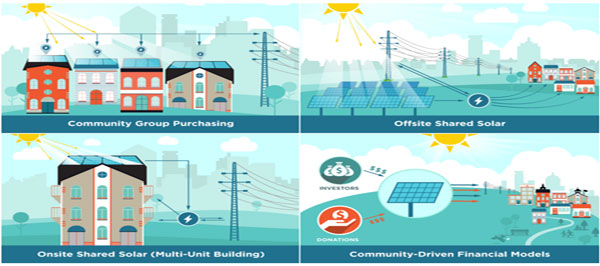At the end of March, The Washington Post published an article entitled “Why this new solar market could be set to explode,” pointing to a report from Rocky Mountain Institute estimating that the untapped market for “community-scale” solar could be somewhere near 30 gigawatts by 2030.
If you’re wondering how community-scale solar is defined, Vox does a great job breaking down the different models in a March 24 article.
For our purposes, “community solar” generally refers exclusively to offsite shared solar, where multiple offtakers subscribe to a single large system located elsewhere.
 This graphic from the Department of Energy illustrates different shared solar models. Credit: SOLSystems
This graphic from the Department of Energy illustrates different shared solar models. Credit: SOLSystems
As community solar has grown in popularity and the market matures, developers are increasingly asking us if the added complexity of these deals is unattractive to tax equity investors.
The answer, of course, depends on the investor, but one thing is certain: all community solar models are not created equally.
Here are a few factors to consider when trying to better gauge investor interest in tax credits for a given community solar portfolio:
1) Number of Subscribers or Offtakers – Shared solar models that require fewer subscribers and allow for non-residential offtakers reduce transactional complexity. Take Minnesota, for example, where a minimum of only five offtakers are required for a given deal, and compare it to Colorado, which requires at least 25 subscribers for every 500kW. In Colorado, this could mean 100 subscribers if a developer builds to the 2MW cap.
The Minnesota model has fewer operational complexities (e.g. billing to 5 customers vs. 100 or more). Moreover, requiring fewer participants will make it easier for a municipality or an entity with investment grade credit to participate. Models that require more participants tend to push developers towards aggregating residential offtakers, which may be less attractive for some tax equity investors (especially those who have not transacted previously in the residential space). Generally investors prefer to look at only a handful of investment-grade municipal or commercial subscribers.
2) Portfolio and individual project size – Given the complexities of structured finance deals, the bigger the portfolio, the better. Again, take Minnesota. Project sizes are capped at 1MW AC, but some projects are grandfathered in to allow co-location of up to five sites. This allows for project sizes that are up to 5MW AC in size, which can then be paired in a portfolio with other projects. A 20MW portfolio of essentially four distinct 5MW projects will generally have fewer complexities than a 20MW portfolio comprised of twenty distinct 1MW projects, for example.
Apart from the above factors, we prefer structures where participants subscribe to kilowatt hours at a fixed, and not floating, rate (even if the bill credits the offtaker receives from the utility float). Attractiveness of a given portfolio may also depend on the utility territory and if RECs or SRECs may be monetized, adding SREC risk to the portfolio.
Bottom line: yes, community solar can be complicated, and certainly, the devil is in the details. Still, with the right structure, community solar can be a very attractive proposition for a tax equity investor.
















Comments